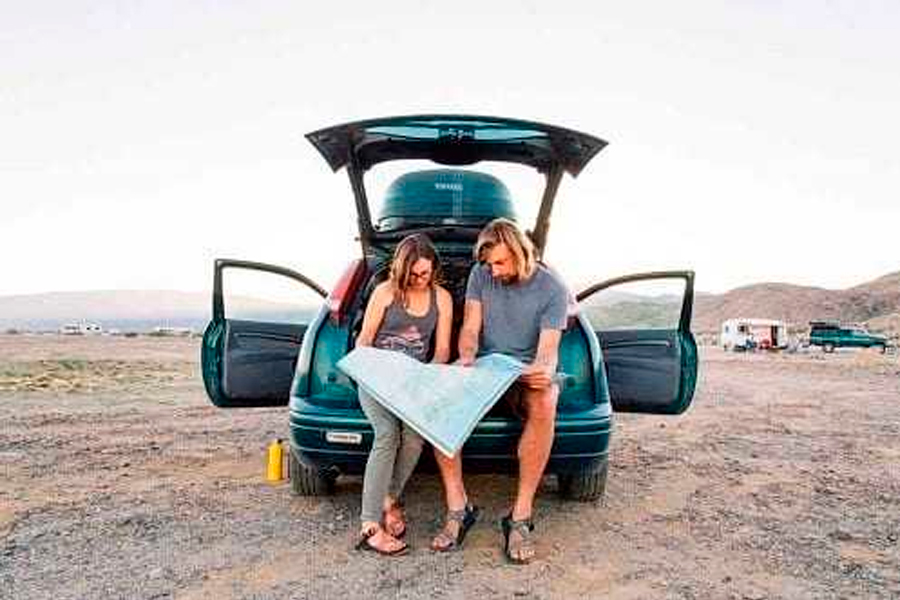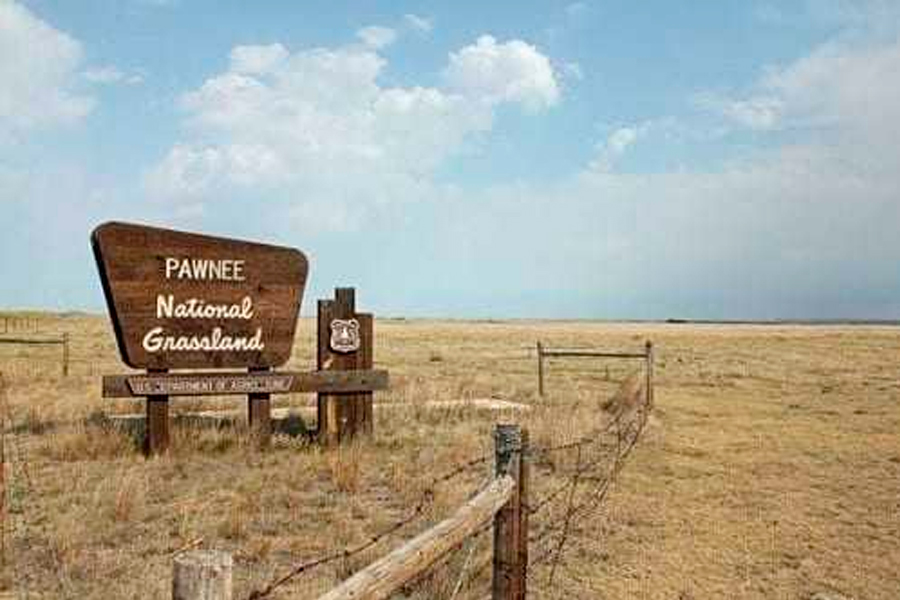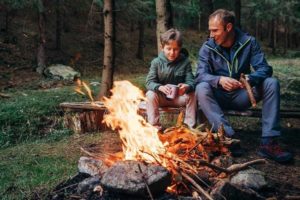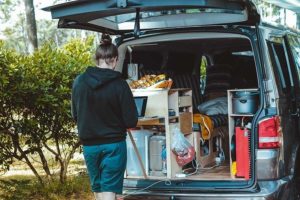Free Camping: A Complete Guide To Camping Cheap on your Next Trip

Camping is all about getting back in touch with nature but it can be tough to justify when you have to pay 20 dollars per night to enjoy it. Although we know that the people who maintain campgrounds need to be paid, it feels a little discouraging when free camping to need to commercialize an activity that consists of returning to nature.
You may have come across people who say that you can’t find any legal campgrounds for free, but they just haven’t tried hard enough. With these tips, you won’t have to tread a legal grey-area to ensure that you find the right free camping grounds. We’ll be covering everything that you need to know to start camping for free.

In this guide, we’ll explain exactly what camping for free means and what to expect while you’re doing it. We will cover the areas where you can camp without paying a fee, but we’ll also take a look at some resources you can use while camping for free. By the end of this guide, you’ll be ready to plan the cheapest vacation of your life!
What is Free Camping?
Free and dispersed camping most often means camping on public lands away from developed recreational facilities. Most public lands are available for free camping, however, there won’t be any facilities for you to utilize during your stay.
It’s important that you conduct some research prior to your stay. You should check the regulations of the area you want to specifically occupy. Your research should answer questions such as: What do I do with human waste? What plants might be endangered in the area? What kind of animals might make an appearance? And how should I store my food? Knowing the answers to these questions will ensure that you are met with success on your camping trip while also being a steward of the land.
Benefits of Free Camping
There are many benefits to free camping aside from the glaringly obvious being, it’s cheap. Check out this list of 6 items to see what you’re getting out of your experience.
1.Wide Open Spaces
Chances are if you’re free camping you’ve made it into the wilderness. Whether you’ve found yourself a shady forest spot or a barren patch of desert, you’ve found a wide-open, wild space to call home for a few nights. This ties us right into our next point…
2.Peace and Quiet
No neighbors!? WooHoo! Enjoy true peace while free camping because the chances are, you won’t have neighbors 10 feet from your picnic table on this camping trip.
3.Wildlife
With wide-open wild spaces and peace comes greater opportunity to see wildlife. This can be both exciting and nerve-wracking. Make sure you’ve read the regulations and prepared properly. If you’ve done everything by the books, an animal sighting should be nothing but exciting!
4.New Challenges
Being farther from civilization often brings new challenges (and better stargazing). Problem-solving and creativity go hand in hand! There’s nothing better than getting things done yourself and figuring out how to survive on your own. Flex your creativity muscles if you get the chance!
5.Trail Proximity
Chances are there are spur trails from your site or at least a marked trail nearby. This means you can quite literally explore in your backyard! Experience nature that many other visitors to the same area have probably overlooked.
6.Cost-Effective
And finally, the glaringly obvious. Free camping is cheap which makes it the best option for traveling on a budget. You can often extend the length of your stay, so seeing more gorgeous sights, if you’re saving money on overnight costs.
What to Expect When Free Camping?
If you’ve only ever ventured into a paid campground, I would keep reading. Knowing what to expect when free and dispersed camping is going to be the key to your trip’s success. It’s important that you’re prepared for what you might be getting yourself into.
No Picnic Tables
No picnic tables, what a bummer. Bring a camp chair and a folding table and you’ll be all set for a fancy dinner while free camping! Be sure to account for what surface you plan to prepare your food on as well.
No Fire Rings
It’s important that you are up to date on the fire regulations where you are staying as well. If you can have a fire and there is no fire ring, please be sure to create your fire where it appears one has been made already. This will provide the least amount of damage to the area. Always make sure fires are completely extinguished before leaving them.
No Potable Water
This means, there won’t be flowing water that is safe for you to drink. You may have a stream, river, or lake nearby but you will need to purify that water before consuming it. If there is no water nearby, be sure to pack in all the water you will need for drinking and cooking purposes.
No Bathrooms
There won’t be bathrooms at your free camping site. Make sure to research exactly what you should be doing with your number 1 and 2. It’s often different from place to place and based on the terrain.
Cell Phone Service
Cell Service is questionable when free camping. Although this shouldn’t be a deal-breaker, it is important to know that you might be completely cut off from the outside world.
First Come First Served
Almost all free and dispersed camping spots are first-come, first served. This means that they don’t take reservations. Although this can be great, especially for last-minute trips, it can also mean that you arrive at your spot to find it already occupied. We suggest you plan ahead and have a few spots in the same vicinity just in case.
The Best Places To Camp For Free
If you want to participate in free camping in the USA, then you’ll need to know the right spots to go to America. Unfortunately, unlike other countries, America has some pretty strict regulations on where you can and can’t camp, and a lot of government property is off-limits if you’re not willing to pay.
National Forests
Whenever free campsites are brought up, national forests immediately come to mind, as they tend to be the most similar option to traditional campgrounds. Of course, national forests are often not as predictable as national parks due to their wild nature, so you’ll have to do a bit more research in advance.
One of the few downsides to camping in a national forest is that there aren’t usually areas set up for campers or people in general. For example, you won’t find many (if any) trash cans, so you’ll have to carry your garbage with you until you get out of the forest, the same goes for picnic tables.
If you already prefer a more self-sufficient camping style, then you’ll love national forests, since you won’t be doing much different from how you would be camping otherwise. Some national forests will even let you start a fire, as long as you have the right permits.
In the end, we would argue that national forests should be your go-to when it comes to camping for free just because they provide most of what you would want out of a camping experience.
National Grasslands
Much like national forests, national grasslands are properties that are managed by the government, and they don’t charge camping fees either. Of course, there is a bit less shelter in national grasslands since they aren’t wooded like the forests, though they are still suitable for camping.

As long as you decide to go on a warm enough day when the wind shouldn’t cause you any troubles, national grasslands should be perfectly suited for use as campgrounds. You’ll have to expect the same lack of amenities that you would get from a national forest, however.
You may have noticed by now that most of the free camping options you’ll come across will require a more independent camping style, and this may either be positive or negative for you. This type of camping will be best suited for people with tents, as RVs often don’t have enough parking space in these grasslands.
How Do You Find these Free Camping Locations?
We have put together a PDF with a list of resources (URLs) where you can find free camping locations for your convenience. Check out the free camping locations located nearby.
Bureau Of Land Management (BLM) Land
The Bureau of Land Management is an agency that falls within the United States Department of the Interior. It oversees 247.3 million acres of public lands which comes out to about one with of the country’s landmass. Although BLM land often has developed campgrounds, dispersed camping is the way to go if you’re looking for free camping. Unlike National Forests and Grasslands, BLM land is typically arid as opposed to forested or grassy, so you’ll have to prepare for that type of camping.
As you would expect from the climate, the vast majority of BLM land is found in the western and southwestern parts of the United States. If you have the right equipment to deal with the rigors of an arid climate, then you’ll find that BLM land is often perfectly suited for your needs.
BLM lands are available for free camping for up 14 days at a time in 28 days unless otherwise stated by signage. When camping for free on BLM land, campers may not leave their personal property unattended for more than 10 days. Find BLM land on a map, google earth it, and find what looks like a dirt road to travel down. Chances are, you’ll find yourself a pretty rad spot to spend the night!
Keep in mind that not all BLM land is created equal, and some of it is already earmarked for other uses or even camping, so some of them may feature paid campgrounds.
We would recommend looking around to see if there is any suitable BLM land in your area. One of the main advantages of camping in one of these places is that you can choose any form of camping that you desire. Be it car camping, free tent camping, and even RV camping can be practiced in these areas.
Backcountry Camping
When backcountry camping, you may need a permit or you might just simply need to hike in and find a tent spot. Either way, you should be consulting a map to see where it is legal to camp.
Backcountry camping may or may not require a permit depending on where you are exploring. Be sure to check the regulations during your time planning. Permits can sometimes cost you a small fee and other times they are free and simply designed to limit use. The best way to find backcountry free camping sites is with a map! We suggest purchasing a map of the area you’re hoping to explore and sleep in. From there, access the map legend to find what symbol they use for a campsite. Once you know what you’re looking for, you’re bound to find a lot of backcountry camping sites in the area you are visiting. It’s important to know that not all backcountry camping sites will be found on a trail. Sometimes these sites can be found off of seasonal roadways, rivers, and lakes as well. The possibilities are endless.
Backcountry camping requires serious preparation and is not suggested for those who are new to camping and the outdoors. It is a great way to stay and explore a place for free or very cheap. It is also an amazing way to take the path less traveled and see sights that the majority of visitors miss!
Boondocking Spots
Sometimes you’re just passing through a place and need a spot to sleep. Many Van Life and RVers will refer to free camping without amenities or hookups as Boondocking. Rest stops, Walmart Parking lots, and visitors centers often let free overnight parking. Use your time by grabbing a bit to eat, stocking up on supplies, or grabbing some informational fliers on the place you’re visiting.
Please be careful when choosing your boondocking spot. Do your research and make sure the lot you’re choosing to sleep in allows overnight parking. There are a ton of spots that legally allow overnight parking, you just need to know where to look.
How Do You Find these Free Camping Locations?
We have put together a PDF with a list of resources (URLs) where you can find free camping locations for your convenience. Check out the free camping locations located nearby.
Get Free Camping Location List
Is Free Camping Legal?
One of the most common questions that we hear when it comes to this subject has to do with whether or not it’s legal to camp for free. Of course, the legality of camping for free depends on where exactly you decide to camp, as various properties will have different laws and bylaws.

For example, if you decide to post up your camp on someone’s property, like a farm, then you will be trespassing, and you can certainly be persecuted by the law for this. Even if you find yourself on government land where camping is outlawed, you will still be infringing the law to a certain extent.
When looking for the best free campground, you’ll have to consider what you’re allowed to do there and whether or not camping is explicitly forbidden. You’ll want to look for land that is designated for public use in particular, as that will ensure that you face no problems with the law.
In the end, we would recommend erring on the side of caution, as you may end up paying a hefty fine that can be more than ten times the price of admission to a campground.
Conclusion
We hope that this guide has given you the information you need to find free camping opportunities. You should now have the confidence to plan a free, low cost, adventure using our PDF, and the knowledge you’ve gained from this post. Feel free to leave us a comment if you’ve found an awesome free camping spot or resource you think people would benefit from.
Resources:




